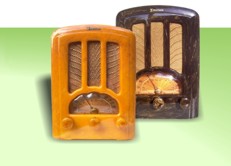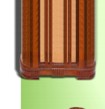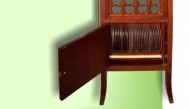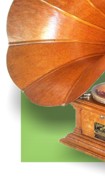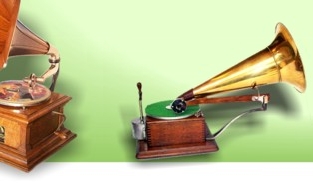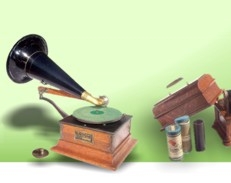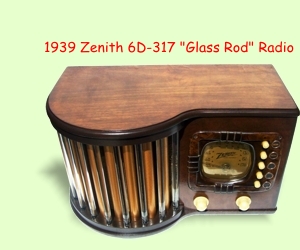|
In a Nutshell
The extremely rare Recordeon Grand Opera Phonograph with its universal Heineman-Meisselbach tonearm - reproducer system, a strong 2-spring motor and its automatic stop, is all you need for your 78 rpm collection. It plays all record formats of the early 1900's, that is Victor - type lateral cut records, Edison diamond discs and all formats of Pathé records (click pict.40 for youtube video)

Introduction:
Finding some background information about this "Grand Opera" phonograph, made by "Recordeon Co. Milwaukee, Wisconsin", is very hard. The phonograph and gramophone landscape of 1920 (that is just before radio came into households) is characterized by a large number of competing manufacturers with Victor Talking Machine, Columbia Graphophone Co., and Edison being the big three. R. J. Wakeman in his article about "Off Brand Talking Machines" quotes more than 400 manufacturers (ref.1). Presto, the American Music Trade Weekly (ref.2) of June 26, July 3 and 10, 1920, under "Some Good Ones" lists 61 brands, from Apollophone to Widdi-Comb. For each one they give some suggestions as to why they "seem to be winning" (pict.29). For Recordeon we find: "Three big plants are operated by the manufacturers of this phonograph. It is a standard product capable of withstanding competition, and are in very great demand. It is promoted along high-toned lines and the manufacturers make a specialty of service which sustains its customers. Handsome cabinets and metal parts of the latest and most durable. Fine tonal results, also. General Mfg. Corporation, 1520 Buffum Street, Milwaukee, Wis." The only other instance of Grand Opera Phonographs is a 11-page catalog, reproduced by Peter Liebert in ref.3, where my phonograph is shown on page 5 (picts.27,28). Peter wrote me this: "Because so many companies existed (I have a list of just those that advertised in "Talking Machine World", a trade publication, that numbers over 250... "Recordeon" is not listed, however), and so few examples from each company survive, information is hard to come by, and parts are almost impossible to find." Fortunately my phonograph is complete. Parts were often unique, since patent infringement was severely fought against by the big three, and were mostly invented and developed by inventors, often without permanent affiliations. These parts show abundant patent information, for example the tonearm with its sophisticated cardan joint and springloaded strain relief has been invented by Shular Baum, affiliated with the Century Cabinet Co. New York, that also made the cabinet (picts.13,26), the motor by Pliny Catucci, affiliated with Meisselbach and Brother (picts.18,25) - yes, the same Meisselbach and Catucci, who made the famous fishing reels by Meisselbach-Catucci Reel Company (see historians below). The 2-spring motor must have been made by Meisselbach, since it is identical to their model 12 (pict.35). The automatic stop has been made by Thomas W. Kirkman (picts.23-25), who had its own factory and sold to many of these independent phonograph manufacturers. The boom was over in 1921 and the depression was the final straw for the phonograph industry.
Additional information:
ref.1: https://apsblobdeve.blob.core.windows.net/article-pdf/Book_General_Off-Brands.pdf
ref.2: http://presto.arcade-museum.com
ref.3: http://www.nipperhead.com/old/grandop.htm
ref.4: https://www.youtube.com/watch?v=mlXyn6kjQ7Y
About my phonograph:
The machine has been thoroughly cleaned and in-depth serviced. The hand-rubbed mahogany cabinet has its original finish and no chips, cracks or deep scratches. The chrome fittings of all parts (turntable, on/off and speed controls, automatic stop, needle cups, tonearm, reproducer, crank) have no corrosion. I strongly assume, the horn grille cloth to be the original one (pict.21). The record storage area is clean and undamaged (pict.6). The phonograph plays loud and clear without any motor noise. I made a youtube video (click on pict.40 or go to ref.4) with the phonograph playing Elvis Presley "Don't Be Cruel/(Hound Dog)" [RCA Victor 20-6604, 1956], 笠置シヅ子 (Shizuko Kasagi) "Tokyo Boogie Woogie/(My Dear Little Box)" [Nippon Columbia A339, 1946], The Top Notchers "Forget Me Not/(When The One You Love Loves You)" [Edison Diamond Disc 51453, 1924], and Léonce Bergeret "Refrains Suisses/(Métroplitain-Express)" [Pathé Center Start P3011, 1921] (pict.37). These records as well as many more are available on request. It is highly recommended to use the proper needles for each type of record, regular steel (one needle per record) or sapphire or diamond tipped needles for lateral, sapphire tipped for Edison, and sapphire ball tipped for Pathé (pict.36). They are all readily available on Ebay. A smaller Grand Opera phonograph in an oak cabinet was recently for sale on eBay for $595 (pict.30).
The camera used for the video is an old Kodak C643, the microphone of which is not prepared to accept the dynamics offered by the graphophone, as it flattens it due to its AVC (automatic volume control). It causes some high-pitched sounds, as well. Please
e-mail me (Kris) for any questions, ich spreche Deutsch, je parle Français.
For the historians only:
The hundreds of small independent ("Off Brand") phonograph companies of the 1920's could not produce all the needed parts by themselves. They depended on other companies specializing in providing these parts. The two most important were Otto Heineman(n) [1876-1965] and August Frederick Meisselbach [1865-1927]. Jehuda Otto Heinemann (pict.39) was born in Lüneburg, Germany, as the 7th of 17 siblings, his father, Jewish banker Marcus Heinemann (pict.38) was later prosecuted by the Nazis. Leaving his small Berlin company Carl Lindström Aktien-Gesellschaft for repeated visits to New York he got stranded, together with brother Adolph at the outbreak of war in 1914, and founded in 1915 the Otto Heineman Phonograph Supply Company, in the beginning only selling his "The Motor of Quality".
August Frederick (Gus) Meisselbach was born in Newark, NJ, as the second son of German immigrants who came to the US in the 1850s. Together with brother William and their father they founded the "Meisselbach Bros., Fishing Reel Mfrs." in the late 1800's. In 1910 Meisselbach together with his chief engineer Pliny Catucci, an Italian immigrant, founded the Meisselbach-Catucci Corporation, that expanded heavily into the phonograph parts sector. In 1917 Meisselbach sold his company to Otto Heinemann and became vice president of Otto Heineman Co.; they now made motors, tonearms, sound boxes and needles, and - Meisselbach-Catucci fishing reels in Newark. They established in 1918 the record manufacturing company OKeh ("The Record of Quality") in Springfield, Mass.. The name is said to be the initials of Otto K. E. Heineman; I found however no indication what K. E. stands for and accept the alternative, that it is an Indian spelling of o.k. In 1919, Meisselbach lost his brother, in 1921 moved the fishing reel business to Elyria, Ohio and in 1922, 5 years before his death, introduced the "OKEH" line of level-wind reels.
Examining cross licensing of phonograph parts between the myriads of companies is one of the most difficult tasks. The Heineman-Meisselbach motor No.12 for example can also be found as their No.2A in the inventory of the Standard Phonograph Motors Inc., Chicago, which itself is the successor of Krasco (Krasberg Engineering and Mfg. Co.), that had the sales rights also for the Universal Stamping & Mfg. Co. and the Sterling Devices Co.
|



